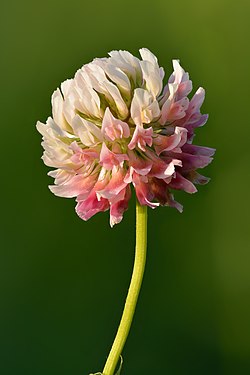From Wikipedia
Open on Wikipedia
| Alsike clover | |
|---|---|

| |
| Scientific classification | |
| Kingdom: | Plantae |
| Clade: | Tracheophytes |
| Clade: | Angiosperms |
| Clade: | Eudicots |
| Clade: | Rosids |
| Order: | Fabales |
| Family: | Fabaceae |
| Subfamily: | Faboideae |
| Genus: | Trifolium |
| Species: | T. hybridum
|
| Binomial name | |
| Trifolium hybridum | |
| Subspecies[1] | |
| |
| Synonyms[1] | |
|
List
| |
Trifolium hybridum, the alsike clover,[2] is a species of flowering plant in the pea family Fabaceae. The stalked, pale pink or whitish flower head grows from the leaf axils, and the trifoliate leaves are unmarked. The plant is up to 40 centimetres (1.3 ft) tall,[3]: 152 and is found in fields and on roadsides – it is also grown as fodder (hay or silage). It has been linked with toxicity in horses and has some agricultural uses. The plant blooms from spring to autumn (April to October in the northern hemisphere).[4] Originating in mainland Europe, it has become established as an introduced plant in the British Isles[5] and throughout the temperate regions of the world.[6]
History
[edit]
Despite its scientific name, alsike clover is not of hybrid origin. The plant gets its common name from the town of Alsike in Sweden from which Linnaeus first described it. He thought it was a cross between white clover (T. repens) and red clover (T. pratense), but in this he was mistaken and it is a separate species.[7][8]
Description
[edit]Alsike clover is a perennial plant with a semi-erect, sparsely branched, grooved stem, hairy in its upper regions. The leaves are alternate and stalked with small stipules. The leaves have three blunt-tipped ovate, unspotted leaflets with finely toothed margins. The inflorescence has a long stalk and is densely globose. The individual florets have a five-lobed calyx and an irregular corolla consisting of five pink petals, one upstanding "standard", two lateral "wings" and the lower two fused to form a "keel". There are ten stamens and a single carpal.[9]
Distribution and habitat
[edit]Alsike clover is native to much of southern Europe and southwestern Asia, especially in mountainous regions. It is widely cultivated and used as a forage crop and for this purpose the subspecies T. h. hybridum is used and this has become naturalised further north in Europe and in other parts of the world. Its natural habitat is fields, meadows, roadsides, banks and waste ground. When added to seed mixtures, it seldom persists once the sward has closed up.[10]
Use in horticulture and agriculture
[edit]Trifolium Hybridum has been found to quickly lower the pH of soil, increasing its viable area of reproduction,[11] whilst reducing the bio-density of weeds by up to 57%.[12] Under the right conditions it may become invasive unless properly managed.[13] With regard to inbreeding, it was found that there were disadvantageous changes to height, persistence, and vigor unless selectively bred for said traits.[14]
Toxicity
[edit]There is limited evidence of Trifolium Hybridum having toxic effects on horses including photosensitization and Alsike clover poisoning. Photosensitivity in horses, also known as alsike rash, is a reversible condition in which the mechanism is unknown.[15] A diet in equestrians of at least 20% Trifolium Hybridum over the course of four weeks could lead to poisoning which includes deleterious neurological effects and liver failure. The active toxin is unknown.[16] The plant can irritate skin if handled.[17]
References
[edit]- ^ a b "Trifolium hybridum L." Plants of the World Online. Royal Botanic Gardens, Kew. Retrieved 29 August 2024.
- ^ NRCS. "Trifolium hybridum". PLANTS Database. United States Department of Agriculture (USDA). Retrieved 15 December 2015.
- ^ Blamey, M.; Fitter, R.; Fitter, A (2003). Wild flowers of Britain and Ireland: The Complete Guide to the British and Irish Flora. London: A & C Black. ISBN 978-1408179505.
- ^ Lee Peterson, Roger Tory Peterson, Lee Allen Peterson, A Field Guide to Edible Wild Plants of Eastern and Central North America, Boston, Houghton Mifflin, 1978, c1977. 330 p. (The Peterson field guide series, no. 23): pp 56, 124. Google Books
- ^ C. A. Stace, Interactive Flora of the British Isles, a Digital Encyclopaedia: Trifolium hybridum. ISBN 90-75000-69-3. (Online version) Archived 2011-06-08 at the Wayback Machine
- ^ A R Clapham, T G Tutin, E F Warburg, Flora of the British Isles, Cambridge, 1962, p 341
- ^ Publications & Information: Alsike Clover Archived 2012-12-30 at the Wayback Machine. Montana State University.
- ^ Clark, G. H. (1913). Fodder and Pasture Plants. Canada Dept. of Agriculture.
- ^ "Alsike Clover". NatureGate. Retrieved 2013-12-24.
- ^ "Trifolium hybridum (Alsike Clover)". Online Atlas of the British and Irish Flora. Retrieved 2013-12-24.
- ^ Paplauskienė, V., & Dabkevičienė, G. (2012). A study of genetic diversity in Trifolium hybridum varieties using morphological characters and ISSR markers. Žemdirbystė–Agriculture, 99, 313-318.
- ^ Ross, Shirley M.; King, Jane R.; Izaurralde, R.César; O'Donovan, John T. (July 2001). "Weed Suppression by Seven Clover Species". Agronomy Journal. 93 (4): 820–827. doi:10.2134/agronj2001.934820x. ISSN 0002-1962.
- ^ "ALSIKE CLOVER" (PDF). Plant Fact Sheet/Guide. National Plant Data Center.
- ^ Townsend, C. E.; Remmenga, E. E. (March–April 1968). "Inbreeding in Tetraploid Alsike Clover, Trifolium bybridum L.". Crop Science. 8 (2): 213–217. doi:10.2135/cropsci1968.0011183X000800020024x. ISSN 0011-183X.
- ^ Nation, P. Nicholas (May 1989). "Alsike clover poisoning: A review". Can Vet J. 30 (5): 410–5. PMC 1681272. PMID 17423321.
- ^ Hovda, Lynn R.; Benson, Dionne; Poppenga, Robert H., eds. (19 September 2021). "Alsike Clover ( Trifolium hybridum )". Blackwell's Five‐Minute Veterinary Consult Clinical Companion (1st ed.). Wiley. pp. 259–264. doi:10.1002/9781119671527.ch51. ISBN 978-1-119-67149-7.
- ^ Reiner, Ralph E. (1969). Introducing the Flowering Beauty of Glacier National Park and the Majestic High Rockies. Glacier Park, Inc. p. 122.